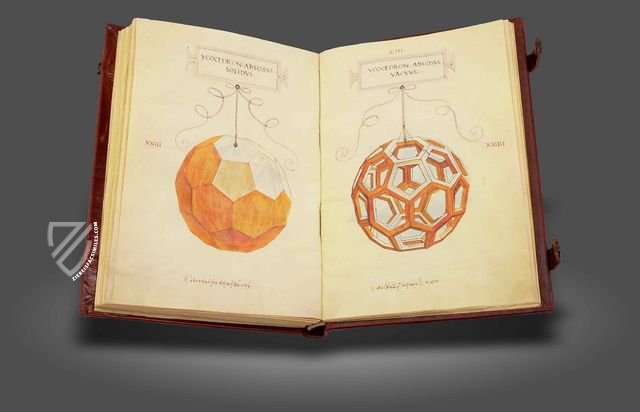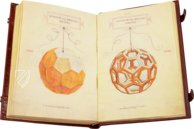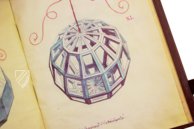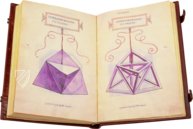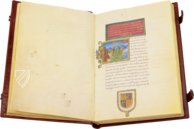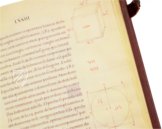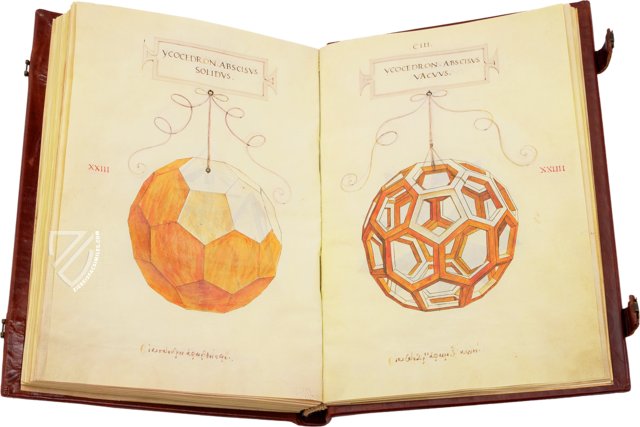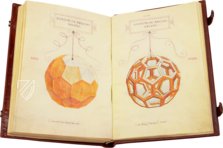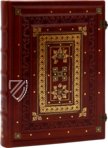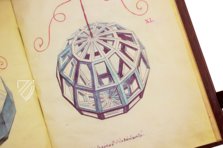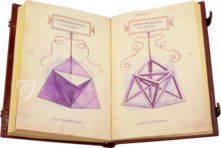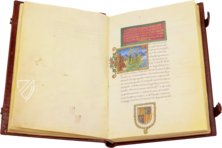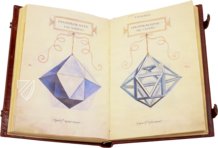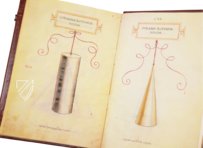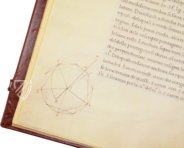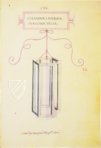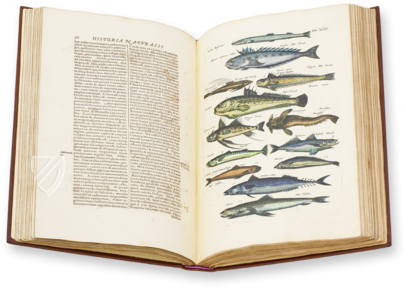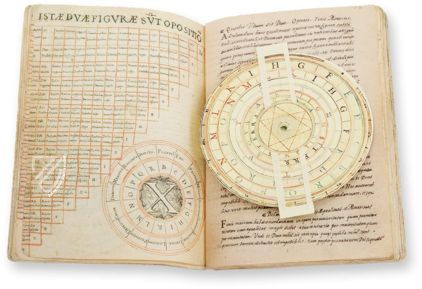De Divina Proportione
(1,000€ - 3,000€)
With their treatise on the golden ratio and its application to various arts, the mathematician Luca Pacioli and the painter Leonardo da Vinci managed to create a work, which was the most-widely disseminated mathematical work for several centuries. Thanks to its clearly understandable texts and gorgeous and interesting illustrations, it has lost none of its impact outside of mathematical circles. The text consisting of three separate manuscripts originated ca. 1488 in Milan and was published on the 1st of July, 1509 in Venice. Particularly worthy of note are da Vinci’s illustrations, which follow the text and are probably the first depictions of skeletons to make possible the distinction of the front side from the back.
De Divina Proportione
For more than one hundred years, the De Divina Proportione was the most widely circulated mathematical work, which also had a great impact outside of mathematical circles. Ca. 1488, Leonardo da Vinci (1452–1519) induced his friend, the mathematician and Franciscan monk Luca Pacioli (1445–1517), to create a treatise on the golden ratio. In doing so, a work consisting of three separate manuscripts illustrated by the first truly instructive spatial representations of polyhedrons.
The Union of Mathematics and Art
The three-part text originated between 1496 and 1498 and concerns the mathematical proportions and their applications to geometry and art through perspective and architecture. The first manuscript is focused on the study of the golden ratio from a mathematical perspective and devoted itself to the application thereof in various arts. It is followed by treatises concerning the use of perspective in the works of painters such as Piero della Francesca (ca. 1420–1492), Melozza da Forli (1438–1494), and Marco Palmezzano (1456–1539). The 20 chapters of the second part discuss the ideas of Vitruvius (1st c. B.C.E.) concerning the application of mathematics to architecture, while the third manuscript is predominantly an Italian translation of Piero della Francesca’s Latin texts concerning the five Platonic solids.
Astounding Geometric Illustrations
Two excerpts with interesting illustrations follow the text portion. The first part consists of 23 large initials with a ruler and compass by Pacioli himself. Having said this, the 60 woodcuts of drawings by Leonardo da Vinci are even more significant. They are probably the first depictions of skeletons to make the distinction between the front and back sides possible. Additionally, one finds the famous Vitruvian Man in da Vinci’s work, which discovers a correlation to the human aspiration according to the knowledge of god.
Codicology
- Alternative Titles
- La Divina Proporción
De Divina Proportione. El verdadero Código Da Vinci, la obra perfecta - Size / Format
- 260 pages / 28.5 × 20.0 cm
- Origin
- Italy
- Date
- 1498
- Epochs
- Style
- Language
- Script
- Humanistic
- Illustrations
- 23 majuscules by Luca Pacioli and 60 woodcuts after drawings by Leonardo da Vinci
- Content
- Mathematical proportions (for example, the "golden ratio") and their applications in perspective, geometry, and architecture
- Artist / School
- Leonardo da Vinci
Luca Pacioli - Previous Owners
- Galeazzo da Sanseverino
Count Galeazzo Arconati
De Divina Proportione
Skeletal Polyhedron
This polyhedron is virtually perfect and may even originate from the hand of Leonardo da Vinci, a friend and collaborator of Luca Pacioli, the work’s author. In fact, the two Renaissance geniuses lived together in Milan for a time until 1499, when they were forced to flee due to the invasion of King Louis XII of France. Their work from the 1480’s endured after they parted ways in 1506 and became a standard mathematical text as well as one of the most important treatises of the Renaissance.
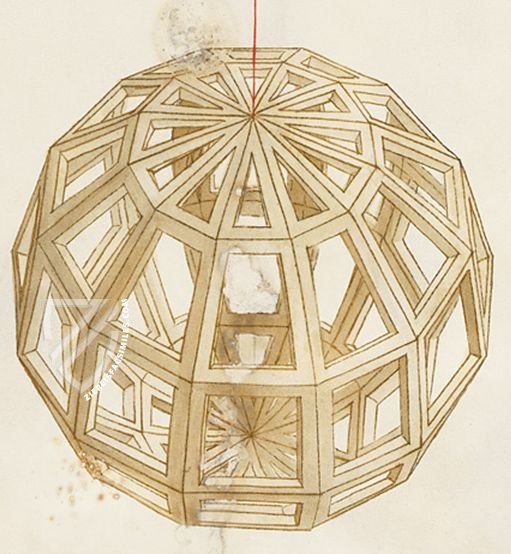
De Divina Proportione
Presentation Miniature
Dressed in the simple brown robes of a Franciscan friar, the author of this important mathematical treatise, Luca Pacioli, is depicted here presenting the work to the man who patronized his labor, Ludovico Sforza. One of the greatest art patrons of Renaissance Italy, Ludovico’s coat of arms as Duke of Milan are presented at the bottom of the page.
The attention to detail is incredible for an image this size, especially with regard to the gestures and postures of the figures and their garments’ fall of folds. Presented within an elegant golden frame as though it were a small panel painting, this miniature is only a centerpiece of a perfectly composed page, including a brilliant crimson field of golden text at the top of the page.
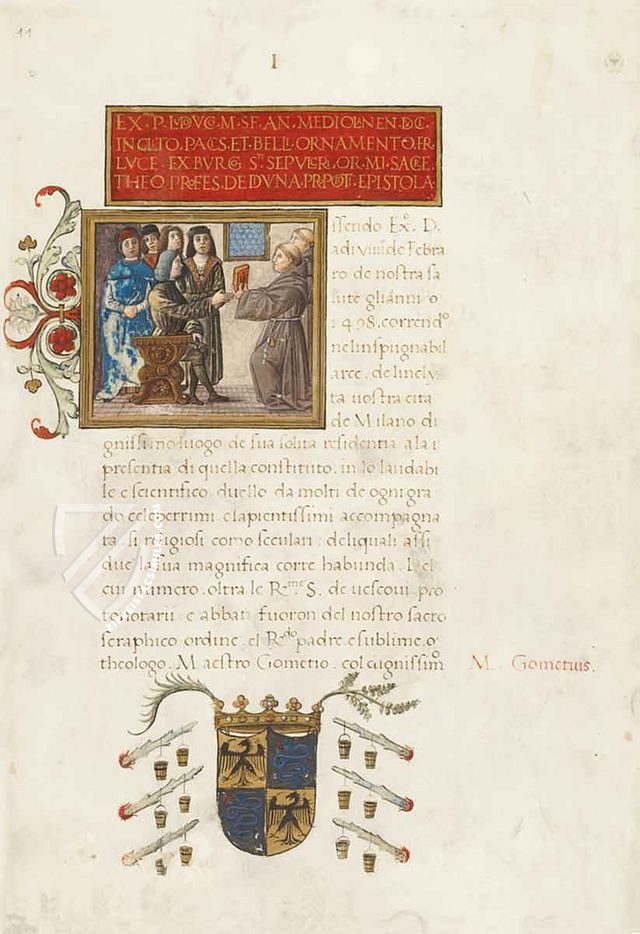
#1 La Divina Proporción
Language: Spanish
(1,000€ - 3,000€)
#2 De Divina Proportione. El verdadero Código Da Vinci, la obra perfecta
Language: Spanish
(1,000€ - 3,000€)
- Treatises / Secular Books
- Apocalypses / Beatus
- Astronomy / Astrology
- Bestiaries
- Bibles / Gospels
- Chronicles / History / Law
- Geography / Maps
- Saints' Lives
- Islam / Oriental
- Judaism / Hebrew
- Single Leaf Collections
- Leonardo da Vinci
- Literature / Poetry
- Liturgical Manuscripts
- Medicine / Botany / Alchemy
- Music
- Mythology / Prophecies
- Psalters
- Other Religious Books
- Games / Hunting
- Private Devotion Books
- Other Genres
- Afghanistan
- Armenia
- Austria
- Belgium
- Colombia
- Croatia
- Cyprus
- Czech Republic
- Denmark
- Egypt
- Ethiopia
- France
- Germany
- Greece
- Hungary
- India
- Iran
- Iraq
- Israel
- Italy
- Japan
- Lebanon
- Luxembourg
- Mexico
- Morocco
- Netherlands
- Palestine
- Peru
- Poland
- Portugal
- Russia
- Serbia
- Spain
- Sri Lanka
- Sweden
- Switzerland
- Syria
- Turkey
- Ukraine
- United Kingdom
- United States
- Uzbekistan
- Aboca Museum
- Ajuntament de Valencia
- Akademie Verlag
- Akademische Druck- u. Verlagsanstalt (ADEVA)
- Aldo Ausilio Editore - Bottega d’Erasmo
- Alecto Historical Editions
- Alkuin Verlag
- Almqvist & Wiksell
- Amilcare Pizzi
- Andreas & Andreas Verlagsbuchhandlung
- Archa 90
- Archiv Verlag
- Archivi Edizioni
- Arnold Verlag
- ARS
- Ars Magna
- ArtCodex
- AyN Ediciones
- Azimuth Editions
- Badenia Verlag
- Bärenreiter-Verlag
- Belser Verlag
- Belser Verlag / WK Wertkontor
- Benziger Verlag
- Bernardinum Wydawnictwo
- BiblioGemma
- Biblioteca Apostolica Vaticana (Vaticanstadt, Vaticanstadt)
- Bibliotheca Palatina Faksimile Verlag
- Bibliotheca Rara
- Boydell & Brewer
- Bramante Edizioni
- Bredius Genootschap
- Brepols Publishers
- British Library
- C. Weckesser
- Caixa Catalunya
- Canesi
- CAPSA, Ars Scriptoria
- Caratzas Brothers, Publishers
- Carus Verlag
- Casamassima Libri
- Chavane Verlag
- Christian Brandstätter Verlag
- Circulo Cientifico
- Club Bibliófilo Versol
- Club du Livre
- CM Editores
- Collegium Graphicum
- Collezione Apocrifa Da Vinci
- Comissão Nacional para as Comemorações dos Descobrimentos Portugueses
- Coron Verlag
- Corvina
- CTHS
- D. S. Brewer
- Damon
- De Agostini/UTET
- De Nederlandsche Boekhandel
- De Schutter
- Deuschle & Stemmle
- Deutscher Verlag für Kunstwissenschaft
- DIAMM
- Droz
- E. Schreiber Graphische Kunstanstalten
- Ediciones Boreal
- Ediciones Grial
- Ediclube
- Edições Inapa
- Edilan
- Editalia
- Edition Deuschle
- Edition Georg Popp
- Edition Leipzig
- Edition Libri Illustri
- Editiones Reales Sitios S. L.
- Éditions de l'Oiseau Lyre
- Editions Medicina Rara
- Editorial Casariego
- Editorial Mintzoa
- Editrice Antenore
- Editrice Velar
- Edizioni Edison
- Egeria, S.L.
- Eikon Editores
- Electa
- Emery Walker Limited
- Enciclopèdia Catalana
- Eos-Verlag
- Ephesus Publishing
- Ernst Battenberg
- Eugrammia Press
- Extraordinary Editions
- Fackelverlag
- Facsimila Art & Edition
- Facsimile Editions Ltd.
- Facsimilia Art & Edition Ebert KG
- Faksimile Verlag
- Feuermann Verlag
- Folger Shakespeare Library
- Franco Cosimo Panini Editore
- Friedrich Wittig Verlag
- Fundación Hullera Vasco-Leonesa
- G. Braziller
- Gabriele Mazzotta Editore
- Gebr. Mann Verlag
- Gesellschaft für graphische Industrie
- Getty Research Institute
- Giovanni Domenico de Rossi
- Giunti Editore
- Graffiti
- Grafica European Center of Fine Arts
- Guido Pressler
- Guillermo Blazquez
- Gustav Kiepenheuer
- H. N. Abrams
- Harrassowitz
- Helikon
- Hendrickson Publishers
- Henning Oppermann
- Herder Verlag
- Hes & De Graaf Publishers
- Hoepli
- Holbein-Verlag
- Hortus Deliciarum
- Houghton Library
- Hugo Schmidt Verlag
- Idion Verlag
- Il Bulino, edizioni d'arte
- ILte
- Imago
- Insel Verlag
- Instituto Nacional de Antropología e Historia
- Istituto dell'Enciclopedia Italiana - Treccani
- Istituto Ellenico di Studi Bizantini e Postbizantini
- Istituto Geografico De Agostini
- Istituto Poligrafico e Zecca dello Stato
- Italarte Art Establishments
- J. Thorbecke
- Jan Thorbecke Verlag
- Johnson Reprint Corporation
- Josef Stocker
- Josef Stocker-Schmid
- Jugoslavija
- Karl W. Hiersemann
- Kasper Straube
- Kaydeda Ediciones
- Kindler Verlag / Coron Verlag
- Kodansha International Ltd.
- Konrad Kölbl Verlag
- Kurt Wolff Verlag
- La Liberia dello Stato
- La Linea Editrice
- La Meta Editore
- Lambert Schneider
- Landeskreditbank Baden-Württemberg
- Leo S. Olschki
- Les Incunables
- Library of Congress
- Libreria Musicale Italiana
- Lichtdruck
- Lito Immagine Editore
- Lumen Artis
- Lund Humphries
- M. Moleiro Editor
- Maison des Sciences de l'homme et de la société de Poitiers
- Manuscriptum
- Martinus Nijhoff
- Maruzen-Yushodo Co. Ltd.
- MASA
- McGraw-Hill
- Militos
- Millennium Liber
- Müller & Schindler
- Nahar and Steimatzky
- National Library of Wales
- Neri Pozza
- Nova Charta
- Oceanum Verlag
- Odeon
- Orbis Mediaevalis
- Orbis Pictus
- Österreichische Staatsdruckerei
- Oxford University Press
- Pageant Books
- Parzellers Buchverlag
- Patrimonio Ediciones
- Pattloch Verlag
- PIAF
- Pieper Verlag
- Plon-Nourrit et cie
- Prestel Verlag
- Princeton University Press
- Prisma Verlag
- Priuli & Verlucca, editori
- Pro Sport Verlag
- Propyläen Verlag
- Pytheas Books
- Quaternio Verlag Luzern
- Reales Sitios
- Recht-Verlag
- Reichert Verlag
- Reichsdruckerei
- Riehn & Reusch
- Roberto Vattori Editore
- Rosenkilde and Bagger
- Roxburghe Club
- Salerno Editrice
- Sarajevo Svjetlost
- Schöck ArtPrint Kft.
- Scolar Press
- Scrinium
- Scripta Maneant
- Scriptorium
- Siloé, arte y bibliofilia
- SISMEL - Edizioni del Galluzzo
- Sociedad Mexicana de Antropología
- Société des Bibliophiles & Iconophiles de Belgique
- Soncin Publishing
- Sorli Ediciones
- Stainer and Bell
- Studer
- Styria Verlag
- Sumptibus Pragopress
- Szegedi Tudomànyegyetem
- Taberna Libraria
- Tarshish Books
- Taschen
- Tempus Libri
- Testimonio Compañía Editorial
- Thames and Hudson
- The Clear Vue Publishing Partnership Limited
- The Facsimile Codex
- The Folio Society
- The Marquess of Normanby
- The Richard III and Yorkist History Trust
- Tip.Le.Co
- TouchArt
- TREC Publishing House
- TRI Publishing Co.
- Trident Editore
- Typis Regiae Officinae Polygraphicae
- Union Verlag Berlin
- Universidad de Granada
- University of California Press
- University of Chicago Press
- Urs Graf
- Vallecchi
- Van Wijnen
- VCH, Acta Humaniora
- VDI Verlag
- VEB Deutscher Verlag für Musik
- Verlag Anton Pustet / Andreas Verlag
- Verlag Bibliophile Drucke Josef Stocker
- Verlag der Münchner Drucke
- Verlag für Regionalgeschichte
- Verlag Styria
- Vicent Garcia Editores
- W. Turnowsky
- Waanders Printers
- Wiener Mechitharisten-Congregation (Wien, Österreich)
- Wissenschaftliche Buchgesellschaft
- Wydawnictwo Dolnoslaskie
- Xuntanza Editorial
- Zakład Narodowy
- Zollikofer AG

